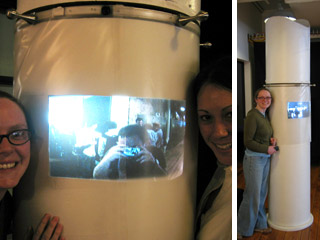INTERACTIVE
|
OBSTRUCTURE • See Through Column • May 2005 |
What is it?It's a Column that lets you see through, all around 360 degrees. This was a project by five students at the New York University's ITP program: Amanda Forte, Cheryl Furjanic, Deirdre M Harvey, Keunyoung Oh and Mauricio Melo. Objects we see every day can become invisible to us. This project aims to provide an impossible viewpoint: the view you would have if you occupied the space where the column stands. This viewpoint is projected back onto a screen that surrounds the column, thus playing with the idea of part of the structure becoming transparent. This transparency is part of the negation of the column caused by providing the view that would exist if it wasn't there. What is the idea?The column in the centre of the ITP (New York University's Interactive Telecommunications Program) lounge has a significant impact on the space it divides it, it obstructs the view from one side to the other. It affects how we move around the space and its presence determines how other objects in the room are arranged. By playing with making a column transparent, the installation draws attention to the object while negating it. It mocks the solidity of the structure. The rear projection onto the screen is a further exploration of the themes of obstruction and visibility: an image can be seen only when there is something in the way. What is the user scenario?The visitor to the installation sees an image of the room projected onto a screen that surrounds the column. The image that is projected onto the screen is generated from a mini wireless camera mounted on the screen. The visitor can move the screen through spinning handles, which modifies what they are looking at. They might start with a view of the opposite side of the column, and move the screen 180 degrees in either way, which would allow them to see themselves staring at the column. and what's the setup?The installation consists of a frame that surrounds the column. A wireless camera is fixed to the frame, pointing outwards. The camera is connected to a projector located inside the column. The images are projected onto a mirror that reflects the image outwards from inside the column which will be rear-projected onto the screen that surrounds the column. |
